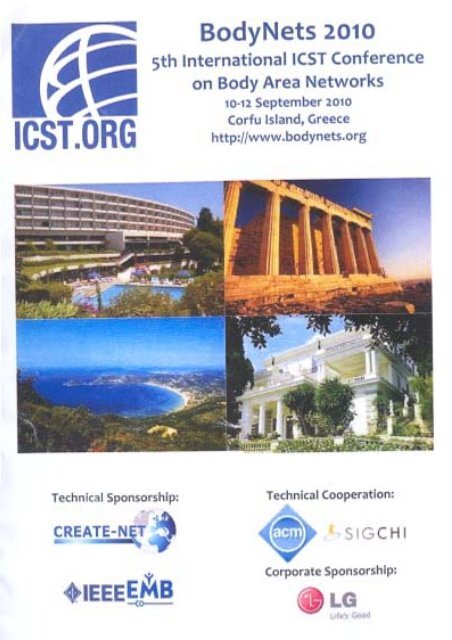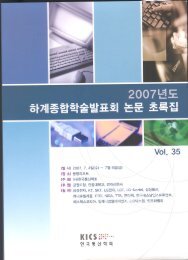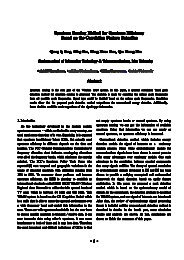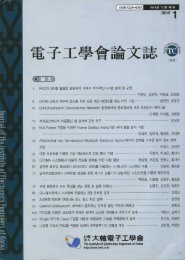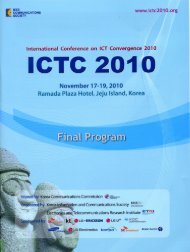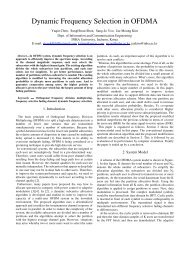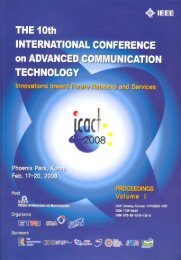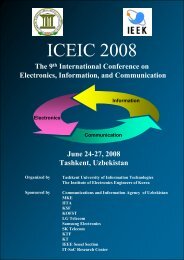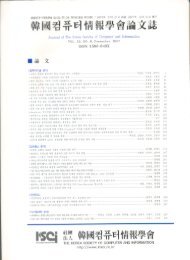WBAN system using GPPM algorithm for IEEE 802.15.TG6
WBAN system using GPPM algorithm for IEEE 802.15.TG6
WBAN system using GPPM algorithm for IEEE 802.15.TG6
You also want an ePaper? Increase the reach of your titles
YUMPU automatically turns print PDFs into web optimized ePapers that Google loves.
<strong>WBAN</strong> <strong>system</strong> <strong>using</strong> <strong>GPPM</strong> <strong>algorithm</strong> <strong>for</strong> <strong>IEEE</strong> <strong>802.15.TG6</strong><br />
ABSTRACT<br />
Jae Ho Hwang ∗<br />
INHA-WiTLAB, INHA University<br />
253, younghyun-dong, Nam-gu<br />
Incheon, Republic of Korea<br />
hoho3676@naver.com<br />
We propose a <strong>WBAN</strong> <strong>system</strong> which supports scalable datarate<br />
modes and is based on the IR-UWB technique. Two<br />
modulation schemes are proposed; an alternated PPM scheme<br />
and a group PPM scheme. We introduce the alternated<br />
PPM by reconfiguring an <strong>IEEE</strong> 802.15.4a <strong>system</strong>. And, we<br />
propose an group PPM modulation scheme which represents<br />
a new modulation method to IR-UWB radio architecture<br />
and can meet the BAN. This <strong>algorithm</strong> increases entropy<br />
and can increase data-rate. Lastly, we simulate two <strong>system</strong>s<br />
in <strong>WBAN</strong> channel, and compare with technical requirement,<br />
and also analyze both the <strong>system</strong>s by calculating a link budget.<br />
Keywords<br />
<strong>WBAN</strong>, UWB, PPM, <strong>GPPM</strong>, Link budget<br />
1. INTRODUCTION<br />
As the growing demand on communication services, various<br />
wireless networking technologies are being developed.<br />
Recent advances in wireless technology have led to the development<br />
of wireless body area networks (<strong>WBAN</strong>), where<br />
a set of communicating devices are located around the human<br />
body. Especially, convergence between IT (in<strong>for</strong>mation<br />
technology) and BT (bio technology) attracts the attention<br />
of many people to the health care services [1].<br />
<strong>IEEE</strong> has launched the task group (TG) <strong>for</strong> <strong>WBAN</strong> in<br />
<strong>IEEE</strong> 802.15 to satisfy the technical trend [2]. It develops<br />
guideline <strong>for</strong> <strong>using</strong> wireless technologies <strong>for</strong> medical device<br />
communications in various healthcare services, and also define<br />
new communication standard with physical layer and<br />
medium access control (MAC) protocol <strong>for</strong> both medical and<br />
nonmedical applications within a range of 3 meters.<br />
<strong>WBAN</strong> <strong>system</strong> can be categorized into medical BAN and<br />
non-medical BAN by its applications. In the case of medi-<br />
∗ corresponding author to provide phone: 82-11-542-3676;<br />
fax: 82-32-865-0480;<br />
Permission to make digital or hard copies of all or part of this work <strong>for</strong><br />
personal or classroom use is granted without fee provided that copies are<br />
not made or distributed <strong>for</strong> profit or commercial advantage and that copies<br />
bear this notice and the full citation on the first page. To copy otherwise, to<br />
republish, to post on servers or to redistribute to lists, requires prior specific<br />
permission and/or a fee.<br />
Copyright 2010 ICST 978-963-9799-41-7 .<br />
Jae Moung Kim<br />
INHA-WiTLAB, INHA University<br />
253, younghyun-dong, Nam-gu<br />
Incheon, Republic of Korea<br />
jaekim@inha.ac.kr<br />
cal applications, these devices are connected to sensors that<br />
monitor vital body parameters and movements. Nonmedical<br />
BAN can be regarded as wearable consumer electronics,<br />
sports, and entertainment devices <strong>for</strong> the on-body communications.<br />
It can also be categorized three parts such as<br />
in-body, on-body, and off-body by its positions [3].<br />
The <strong>WBAN</strong> <strong>system</strong> needs transmission technique <strong>for</strong> ultra<br />
low power devices and operation around the human body.<br />
The ultra wideband (UWB) <strong>system</strong> has some advantages<br />
such as low power radiation, and it exhibits immunity to<br />
the multi-path channel environment. It is operating in an<br />
unlicensed, international frequency band There<strong>for</strong>e pulse position<br />
modulation (PPM) is proposed <strong>for</strong> UWB frequency<br />
band. The proposals are variations or modifications of <strong>IEEE</strong><br />
802.15.4a.<br />
In this paper, we introduce the alternated PPM scheme<br />
and investigate new modulation <strong>for</strong> the <strong>WBAN</strong> physical<br />
layer. This paper is organized as follows. Section II explains<br />
a technical requirement and trend in a standardization work.<br />
The alternated PPM scheme is discussed and the new group<br />
PPM (<strong>GPPM</strong>) method is proposed in section III. Eventually,<br />
both of the modulation schemes are discussed by <strong>using</strong><br />
a simulation results and the link budget.<br />
2. <strong>WBAN</strong> TECHNICAL REQUIREMENT<br />
<strong>WBAN</strong> technical requirement document (TRD [4]) describes<br />
the technical aspects that the TG6 standard must<br />
fulfill. The requirements are summarized in table 1. The<br />
<strong>WBAN</strong> <strong>system</strong> has short transmission range which is up to<br />
3 meters. In this range, a packet error rate (PER) shall<br />
be less than or equal to 10% <strong>for</strong> 256 octet payload with a<br />
link success probability of 95% over all channel condition as<br />
specified in the <strong>WBAN</strong> channel model.<br />
<strong>WBAN</strong> applications have very different requirements. Medical<br />
and vital signals tend to be periodic and low frequency;<br />
interval can vary 1ms to 1000sec. Non-medical applications<br />
such as interactive games, sports and real-time multimedia<br />
application require high data rate transmission. There<strong>for</strong>e<br />
individual link bit rate should be between at least 10 Kbps<br />
at the low end, and 10Mbps at the high end.<br />
And available frequency bands are MICS (medical implant<br />
communication service), MEDS (Medical data service),<br />
WMTS (wireless medical telemetry service) <strong>for</strong> medical<br />
application, and ISM (industrial, scientific, and medical),<br />
UWB bands <strong>for</strong> unlicensed band. Medical <strong>WBAN</strong> applications<br />
have substantial privacy and safety. During the transmission<br />
of encrypted physiological data, patient identifiers<br />
should be particularly protected from overhearing. further-
Table 1: <strong>WBAN</strong> technical requirement<br />
requirement Proposed range<br />
Operating space Up to 3m<br />
Data rate Scalable (Up to 10Mbps)<br />
Target bands MICS, MEDs, ISM, UWB<br />
Device duty cycle Scalable (Up to 100%)<br />
Peak power consumption Scalable (Up to 40mW)<br />
Security High<br />
Safety High<br />
Topology Multiple Simultaneous links<br />
more <strong>WBAN</strong> topology supports the multiple simultaneous<br />
links.<br />
3. <strong>WBAN</strong> PHY SYSTEM<br />
Standard <strong>for</strong> <strong>WBAN</strong> developed by the <strong>IEEE</strong>802.15 task<br />
group 6 which was <strong>for</strong>med in November 2007. There are<br />
three categories of potential candidates. One of them is narrow<br />
band <strong>system</strong> which used ISM band. The other is UWB<br />
based technique. Last one is body line communication. One<br />
of the potential candidates is <strong>using</strong> UWB based technique.<br />
This overcomes the bandwidth limitations of narrow band<br />
<strong>system</strong>s, and improves the power consumption. Another advantageous<br />
is that UWB has immune to any interference on<br />
other wireless medical devices.<br />
The proposed IR-UWB <strong>system</strong>s are based on the modifications<br />
of <strong>IEEE</strong> 802.15.4a standard. IMEC proposed enhanced<br />
modulation scheme compared to that of the <strong>IEEE</strong><br />
802.15.4a. This technique converts the separate bursts into<br />
concatenated continuous string so that it can increase the<br />
data rate of the <strong>system</strong> [5]. A modified symbol structure<br />
from the <strong>IEEE</strong> 802.15.4a is proposed by TI. It removes guard<br />
interval between possible burst positions. Moreover, they<br />
suggest a new time hopping sequence to avoid ISI caused by<br />
removing the guard interval [6].<br />
3.1 Alternative PPM scheme<br />
Draft document of LR-WPAN UWB <strong>system</strong> are released<br />
by <strong>IEEE</strong> 802.15.4a tasking group. This document is categorizing<br />
UWB PHY <strong>system</strong> to three parts such as, impulse<br />
radio (IR) <strong>system</strong>, chirp spread spectrum (CSS) <strong>system</strong>, and<br />
chaotic signal <strong>system</strong>. Especially IR <strong>system</strong> has many strong<br />
points as good per<strong>for</strong>mance in correlation result. There<strong>for</strong>e<br />
it is used widely in many applications [7].IR <strong>system</strong> is <strong>using</strong><br />
2PPM modulation which is sending data to locate pulse<br />
in different two positions. The IR-UWB <strong>system</strong>s are <strong>using</strong><br />
burst pulse which is a serial of the pulse as code. It has<br />
the advantage like strong to noise and useful to multi-user<br />
<strong>system</strong>.<br />
Figure 1 illustrates the UWB payload frame structure of<br />
the 2PPM method. The PPM method consists of two regions.<br />
For instance, if bit is zero then a burst pulse position<br />
is front PPM position and bit is one a burst pulse is located<br />
in the end. PPM region also divided four hopping region <strong>for</strong><br />
multi-user <strong>system</strong>. On burst region combine serial of UWB<br />
pulse.<br />
The UWB PPM method transmits the wave<strong>for</strong>m during<br />
the kth symbol interval, and may be expressed as follows:<br />
Figure 1: PPM frame structure of the <strong>WBAN</strong> <strong>system</strong><br />
Table 2: Parameter of the alternated PPM scheme<br />
10kbps 100Kbps 1Mbps 10Mbps<br />
Viterbi 0.5 0.5 0.5 0.5<br />
RS coding 0.87 0.87 0.87 0.87<br />
Overall 0.435 0.435 0.435 0.435<br />
nSymbol 32768 4096 256 32<br />
nBurst 1024 128 8 1<br />
nHop 8 8 8 8<br />
Symbol rate (bps) 15.08k 120.6k 1.93M 15.42M<br />
Bit rate (bps) 13.12k 104.9k 1.68M 13.43M<br />
s (k) (t) =<br />
Nburst n=1<br />
Snp(t − g (k) TP P M − h (k) Tburst − nTc) (1)<br />
the superscript (k), 1 ≤ k ≤ Nk, indicates incoming data<br />
bits, where Nk is the number of the input bits. g (k) is the<br />
mapping symbols obtained the kth data bit, Sn is the scrambling<br />
sequence, p(.) is the transmitted pulse shape function,<br />
TP P M is the duration of the binary pulse position modulation<br />
time slot, and h (k) is the hopping sequence that provides<br />
suppression of multi-user interference.<br />
The alternative PPM <strong>algorithm</strong> <strong>for</strong> the <strong>WBAN</strong> <strong>system</strong> is<br />
modified version of the low data rate UWB <strong>system</strong>. To get<br />
the multi data rate from 10kbps to 10Mbps, symbol lengths<br />
are reconfigured as shown in table 2. Concatenated codes<br />
are used <strong>for</strong> error correction which consist of the convolution<br />
code and the RS code which codes have 0.5 and 0.87 coding<br />
rate. These parameters are same to the <strong>IEEE</strong>802.15.4a<br />
standard respectively [7].<br />
Frame structures are reconfigured to support multi data<br />
rates. Chip duration is 2.024nsec which has one UWB pulse,<br />
and number of hopping is 8 chips. To get the 10Mbps data<br />
rate, symbol length set to 32 chips and the number of burst<br />
length set to one chips. There<strong>for</strong>e, symbol rate will have<br />
15.42 Mbps, bit rates is 13.43 Mbps after passing the channel<br />
coding block. Others also similar to 10Mbps mode, the<br />
1Mbps mode is same to the <strong>IEEE</strong> 802.15.4a mandatory <strong>system</strong>.<br />
And 100kbps mode consist of 4096 symbol chips and<br />
128 burst chips to get the 100Kbps data rate after channel<br />
coding. 10Kbps mode need 1024chips burst symbol in the<br />
32768 chips frame.<br />
3.2 Group PPM scheme<br />
In this section, the group PPM method is proposed <strong>for</strong> increasing<br />
entropy by <strong>using</strong> grouping with a continuous symbol<br />
set. The number of cases increase when symbols are
Figure 2: conventional PPM symbols and proposed<br />
<strong>GPPM</strong> extra symbols<br />
grouped. Two symbols from the PPM <strong>system</strong> will express<br />
four numbers of cases as symbol codes: (s11, s12, s21, and<br />
s22) equates to (’0101’, ’0110’, ’1001’, and ’1010’), which<br />
represent the pulse position. The grouping PPM method,<br />
however, has extra symbol codes, such as (’1100’, ’0011’).<br />
In this case, group 2PPM increases entropy as follows. The<br />
conventional PPM symbol and extra symbols which is generated<br />
by grouping is shown in the figure 2.<br />
In equation (2), the entropy of the <strong>GPPM</strong> is 2.5849; this is<br />
larger than the entropy of a conventional two-symbol <strong>system</strong>.<br />
H(S2GP P M ) =<br />
6<br />
i=1<br />
P2GP P M,iI(P2GP P M,i)<br />
= 6 × 1<br />
log 2(6) = 2.5849<br />
6<br />
Generally, number of symbol cases of m-<strong>GPPM</strong> have (Nm)<br />
value, as shown in equation (3).<br />
Nm =<br />
2m × (2m − 1) × . . . × (m − 1)<br />
m × . . . × 2 × 1<br />
And, entropies of m-<strong>GPPM</strong> are also explained as shown<br />
in equation (4).<br />
H(Sm GP P M ) =<br />
m<br />
i=1<br />
= Nm × 1<br />
Pm GP P M,iI(Pm GP P M,i)<br />
Nm<br />
log 2(Nm)<br />
In Table 3, the number of cases and the amount of entropy<br />
is compared <strong>for</strong> each group when <strong>using</strong> the <strong>GPPM</strong> and the<br />
conventional PPM. The m-<strong>GPPM</strong> has an extra symbol set<br />
and increases entropy.<br />
The calculated entropy shows that the <strong>GPPM</strong> method<br />
maximizes the in<strong>for</strong>mation and entropy without an increase<br />
in energy consumption. Two grouping symbols have 0.5849<br />
increases, but this does not increase data-rate in a binary<br />
<strong>system</strong>. However, three and more grouping symbol has integer<br />
number of entropy augmentation; such arrangements<br />
will obtain data-rate enhancements.<br />
<strong>GPPM</strong> <strong>algorithm</strong> has advantage that the frame structure<br />
modification is not required. There<strong>for</strong>e frame structure is<br />
(2)<br />
(3)<br />
(4)<br />
same to PPM structure, but <strong>GPPM</strong> <strong>algorithm</strong> increase data<br />
rate <strong>for</strong> example 3<strong>GPPM</strong> mode has 33% data rate increasement.<br />
The frame length extension cause guard integral extension.<br />
It has immunity of multi path fading channel distortion.<br />
There<strong>for</strong>e this <strong>system</strong> does not requires channel<br />
coding.<br />
This new modulation method can be expressed by a mathematical<br />
equation. The frame structure, length, scramble<br />
and hopping codes are the same in the proposed <strong>system</strong> as<br />
in the conventional method. The equation expressing the<br />
new modulation method is shown below in equation (5).<br />
s (k) (t) =<br />
3<br />
m=1<br />
Nburst n=1<br />
Snp(t − g (k)<br />
m TP P M − h (k) Tburst − nTc)<br />
Where, theg (k)<br />
m represents the mapping data generated to<br />
change the four-input binary data.<br />
In this paper, we use 3<strong>GPPM</strong> <strong>algorithm</strong> to increase data<br />
rate. Table 4 shows the specific parameter <strong>for</strong> each data<br />
rate mode. The frame structure is same to the alternate<br />
PPM mode as shown in the figure 1. The alternated PPM<br />
scheme has 32 chips in whole frame length to get the 10Mbps<br />
data rate, but <strong>GPPM</strong> mode extends 64 chips. This case<br />
symbol rate does not satisfy 10Mbps, but data rate increase<br />
to 10.27Mbps by <strong>using</strong> the <strong>GPPM</strong> <strong>algorithm</strong>. Other modes<br />
also increase frame length compare with the alternated PPM<br />
mode.<br />
4. SIMULATION AND ANALYSIS<br />
In this paper, the alternated PPM scheme and <strong>GPPM</strong><br />
scheme are described in each data rate mode. The alternated<br />
PPM scheme use conventional PPM with channel coding,<br />
but modified parameter to fit the technical requirement.<br />
And the <strong>GPPM</strong> scheme is proposed in each data rate mode.<br />
This is <strong>using</strong> <strong>GPPM</strong> <strong>algorithm</strong> to increase frame length.<br />
In this section, the per<strong>for</strong>mance of alternated PPM scheme<br />
is verified in each data rate mode with AWGN channel and<br />
<strong>WBAN</strong> channel. The proposed <strong>GPPM</strong> scheme also simulates<br />
in the same situation, and compares with alternated<br />
PPM scheme. Finally, two schemes will be compared in the<br />
same situation by <strong>using</strong> the link budget.<br />
Each result is simulated by <strong>using</strong> <strong>system</strong> parameter in table<br />
2 and 4. And <strong>WBAN</strong> channel model and AWGN channel<br />
are used. Especially body surface to external channel model<br />
is used. This channel model consists of four situations such<br />
as front, L-side, R-side, and backside of body [8], and received<br />
<strong>algorithm</strong> is <strong>using</strong> simple energy detector.<br />
4.1 alternative PPM scheme<br />
Table 3: Entropy of Method Each Group<br />
Number PPM Group PPM<br />
of Group # of Case Entropy # of Case Entropy<br />
1 2 1.0000 2 1.0000<br />
2 4 2.0000 6 2.5849<br />
3 8 3.0000 20 4.3219<br />
4 16 4.0000 70 6.1292<br />
5 32 5.0000 252 7.9772<br />
(5)
Table 4: Parameter of the <strong>GPPM</strong> scheme<br />
10Mbps 100Kbps 1Mbps 10Mbps<br />
<strong>GPPM</strong> rate 1.33 1.33 1.33 1.33<br />
nSymbol 655536 4096 512 64<br />
nBurst 2048 128 16 2<br />
nHop 8 8 8 8<br />
Symbol rate (bps) 7.53K 120.6K 0.96M 7.72M<br />
Bit rate (bps) 10.03K 160.4K 1.28M 10.27M<br />
Figure 3: PER per<strong>for</strong>mance of the alternated PPM<br />
in AWGN channel<br />
First, the alternative PPM scheme is simulated to get<br />
the PER curve in the AWGN channel and <strong>WBAN</strong> channels.<br />
Various data rate modes are simulated such as 10K,<br />
100K, 1M, 10Mbps mode.<br />
Figure 3 is shown the PER per<strong>for</strong>mance of alternated<br />
PPM scheme. The required PER per<strong>for</strong>mance is below 10%<br />
when the packets consist of 256 octets which are described<br />
in the technical document. 10Kbps mode satisfies 10% PER<br />
when SNR is under -20dB. It is very good per<strong>for</strong>mance, because<br />
this mode has used 2048 burst chips which will use<br />
average effect. 100Kbps mode and 1Mbps also has good<br />
per<strong>for</strong>mance. The 10Mbps mode satisfy 10% PER per<strong>for</strong>mance<br />
at 9 dB SNR<br />
Especially 10Mbps mode is critical to satisfy technical requirement<br />
due to the short guard interval. If rms delay of<br />
the multi-path channel is longer than guard interval, per<strong>for</strong>mance<br />
will reduce. Figure 4 shows the PER per<strong>for</strong>mance<br />
of 10Mbps mode with <strong>WBAN</strong> channel. This channel model<br />
consist of front (0 ◦ ), sides (90 ◦ , 270 ◦ ), and back (180 ◦ ) position<br />
[9]. The figure shows that it has 10% PER per<strong>for</strong>mance<br />
when SNR is 12dB.<br />
4.2 <strong>GPPM</strong> scheme<br />
In this chapter, the <strong>GPPM</strong> scheme is simulated in the<br />
channel. Various data rate modes are simulated such as<br />
10k, 100k, 1M, 10Mbps mode. Each mode uses the 3<strong>GPPM</strong><br />
<strong>algorithm</strong> and channel coding is not used.<br />
Figure 4: PER per<strong>for</strong>mance of the group PPM in<br />
<strong>WBAN</strong> channel<br />
Figure 5 shows the PER per<strong>for</strong>mance of <strong>GPPM</strong> scheme<br />
in the AWGN channel. Required PER per<strong>for</strong>mance is below<br />
10% when the packets consist of 256 octets. The 10kbps<br />
mode of the <strong>GPPM</strong> scheme satisfies 10% PER when SNR<br />
is under -20dB. It also has good per<strong>for</strong>mance, because this<br />
mode has used 2048 burst chips which will use average effect.<br />
100Kbps mode and 1Mbps also has good per<strong>for</strong>mance.<br />
But PER per<strong>for</strong>mance of the 100Kbps mode is lower than<br />
alternative PPM scheme, because it frame structure are similar<br />
to alternative PPM one but do not has error correcting<br />
block. The 10Mbps mode also satisfies 10% PER per<strong>for</strong>mance<br />
when the SNR is 9 dB.<br />
Figure 6 shows the PER per<strong>for</strong>mance of 10Mbps mode<br />
with <strong>WBAN</strong> channel when <strong>GPPM</strong> scheme is used. This<br />
also simulated in each channel model such as front, sides,<br />
and back position. This per<strong>for</strong>mance figure shows that it<br />
has 10% PER per<strong>for</strong>mance when SNR is 10dB. The per<strong>for</strong>mance<br />
of the proposed scheme is better than alternative<br />
PPM scheme, as the frame length extension technique is<br />
more effective than channel coding.<br />
4.3 Link budget<br />
Previous chapter show the simulation per<strong>for</strong>mance of each<br />
scheme. Especially 10Mbps mode per<strong>for</strong>mance is very important<br />
and sensitive. There<strong>for</strong>e we analyze two schemes<br />
by calculating link budget. This is calculated in table 5 the<br />
peak bit rate of alternated PPM scheme is 13.4Mbps and<br />
<strong>GPPM</strong> scheme is 10.27Mbps, which show that both schemes<br />
are satisfied the <strong>WBAN</strong> technical requirement. Signal power<br />
set to -14.3dBm and center frequency is used 4.4928 GHz.<br />
And communication range is 3meter, and a path loss is -<br />
55.0dB. There<strong>for</strong>e received power is -69.3dB and noise power<br />
is -92.1dBm. Finally the alternated PPM scheme has 6.8dB<br />
link margin, sensitivity is -76.1dB. The <strong>GPPM</strong> scheme has<br />
7.8dB link margin, sensitivity is -77.1dB. As like this, two<br />
<strong>system</strong>s are satisfied <strong>for</strong> the <strong>WBAN</strong> PHY scheme.<br />
5. CONCLUTION
Figure 5: PER per<strong>for</strong>mance of the <strong>GPPM</strong> in AWGN<br />
channel<br />
Table 5: Link Budget<br />
Parameter Alternated PPM <strong>GPPM</strong><br />
Peak bit late 13.4(Mbps) 10.2(Mbps)<br />
Distance 3m 3m<br />
Average Tx Power -14.3(dBm) -14.3(dBm)<br />
Center Freq. 4.4928(GHz) 4.4928(GHz)<br />
Path loss -55.0(dB) -55.0(dB)<br />
Rx power -69.3(dB) -69.3(dB)<br />
Rx Noise Floor -87.0(dB) -87.0(dB)<br />
Rx Noise Figure 10(dB) 10(dB)<br />
Noise Reduction -15.1(dB) -15.1(dB)<br />
Average Noise Power -92.1(dBm) -92.1(dBm)<br />
Minimum Eb/N0 11(dB) 10(dB)<br />
Implementation loss 5(dB) 5(dB)<br />
Link Margin 6.8(dB) 7.8(dB)<br />
Rx sensitivity -76.1(dB) -77.1(dB)<br />
In this paper, we deal with about <strong>WBAN</strong> PHY structure<br />
to satisfy technical requirement. The UWB based technique<br />
is one of the potential candidate techniques. It has<br />
advantages such as improves the power consumption, Interference<br />
immunity, and ease of frame configuration. We<br />
describe the two PHY scheme, one of them is the alternated<br />
PPM scheme, which are based on the modifications of <strong>IEEE</strong><br />
802.15.4a standard. Another is <strong>GPPM</strong> scheme, based on<br />
<strong>GPPM</strong> <strong>algorithm</strong> to increase data rate. The <strong>GPPM</strong> <strong>algorithm</strong><br />
uses the symbol grouping with the conventional PPM<br />
to increase the entropy of the <strong>system</strong>. We simulate two<br />
schemes in the <strong>WBAN</strong> environment. We analyze the potential<br />
of two scheme <strong>for</strong> the <strong>WBAN</strong> <strong>system</strong> by calculate<br />
link budget. It is shown the UWB based <strong>system</strong> has advantage<br />
and satisfies the <strong>WBAN</strong> requirement. Especially<br />
the <strong>GPPM</strong> <strong>algorithm</strong> is more fit to <strong>WBAN</strong> <strong>system</strong>, because<br />
<strong>GPPM</strong> scheme is simple which is not used channel coding,<br />
addition to better per<strong>for</strong>mances.<br />
Figure 6: PER per<strong>for</strong>mance of the <strong>GPPM</strong> in <strong>WBAN</strong><br />
channel<br />
Acknowledgment<br />
This research was supported by Basic Science Research Program<br />
through the National Research Foundation of Korea<br />
(NRF) funded by the Ministry of Education, Science and<br />
Technology (No. 20090066336).<br />
This research was supported by the MKE(The Ministry of<br />
Knowledge Economy), Korea, under the ITRC(In<strong>for</strong>mation<br />
Technology Research Center) support program supervised<br />
by the NIPA(National IT Industry Promotion Agency) (NIPA-<br />
2010-C1090-1011-0007)<br />
6. REFERENCES<br />
[1] Kamya Yekeh Yazdandoost and Ryuji Khono, ”Wireless<br />
Communications <strong>for</strong> Body Implanted Medical Devices,”<br />
in proc. APMC2007, Dec. 2007<br />
[2] Huan-Bang Li et. al., ”Body Area Network and Its<br />
Standardization at <strong>IEEE</strong> 802.15.BAN,” in proc.<br />
MWCS2007, Jul. 2007<br />
[3] Cheolhyo Lee, Jaehwan Kim, Hyung Soo Lee, Jaeyoung<br />
Kim, ”Physical Layer Designs <strong>for</strong> <strong>WBAN</strong> Systems in<br />
<strong>IEEE</strong> 802.15.6 Proposals,” in proc. ISCIT, Sep. 2009<br />
[4] Bin Zhen et. al., ”TG6 Technical Requirements<br />
Document (TRD),” <strong>IEEE</strong> P802.15-08-0037-04-0006,<br />
September, 2008.<br />
[5] Dries Neirynck el al., ”IMEC UWB PHY Proposal,”<br />
<strong>IEEE</strong> 802.15.6, May 2009<br />
[6] June Chul Roh et al., ”Texas Instruments Impulse<br />
Radio UWB Physical Layer Proposal, ” <strong>IEEE</strong> 802.15.6<br />
May 2009<br />
[7] <strong>IEEE</strong> P802.15.4a, ”Wireless Medium Access Control<br />
(MAC) and Physical Layer (PHY) Specifications <strong>for</strong><br />
Low-Rate Wireless Personal Area Networks (WPANs):<br />
Amendment to add alternate PHY”, <strong>IEEE</strong> 802.15.4a,<br />
2007.<br />
[8] K. Y. Yazdandoost et. al., ”Channel model <strong>for</strong> body<br />
area network (BAN),” <strong>IEEE</strong> P802.15-08-0780-09-0006,<br />
April. 2009.


